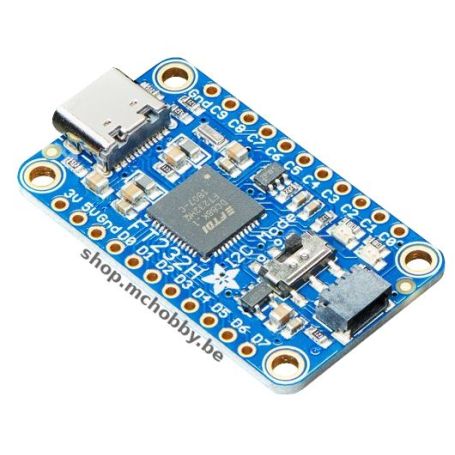GPIO+I2C+SPI extension via USB - FT232H
FT232H from FTDI
- multi-protocol serial interface (I2C, SPI, UART)
- StemmaQT connector (I2C)
- GPIOs
Add I2C, SPI, UART, GPIO on a computer.
Payments are secured by LyraCollect, a French payment collection company.
It is possible to delivered to your home, to a pick-up point or picked up by appointment at MCHobby
We prepare, pack and ship your orders with great respect and care.
Add GPIO, SPI or I2C bus, UART via USB-C interface
It would be really cool to be able to control a small OLED display, or read a color sensor, or flash an LED from your computer! It is of course possible to program an Arduino or Trinket to interact with these peripherals and than send the data back to your computer.
It would be much more interesting if your computer could interact directly with these peripherals/sensors.
Well, with the FT232H Breakout, your computer/Raspberry-Pi can interact directly with SPI/I2C/serial peripherals or control GPIOs.
So what can an FT232H chip do? This chip from the manufacturer FTDI is similar to the USB to serial converter but with the addition of a 'synchronous multi-protocol serial motor' that allows it to support many standard protocols such as SPI, I2C, UART serial, JTAG and more! There are even practical GPIO pins that can be read and edited to do things like flashing LEDs, reading switches or buttons, and so on. The FT232H breakout is a bit like adding a Swiss knife series protocols on your computer :-)
This component is particularly useful and powerful when you want to use Python (for example) to quickly iterate and test peripherals using I2C, SPI or I/O inputs outputs. You are in direct communication with your hardware. There is no intermediate Arduino firmware to which your program must communicate (Arduino firmware which must itself communicate with the sensors).
The Breakout is equipped with a FT232H chip and a configuration EEPROM. You can learn much more about the FT232H from the FTDI page. See also the tutorial section of this datasheet how to get started and use the FT232H with Mac/Win/Linux in Python.
Technical details
Tutorial
- Tutorial to use this FT232H in Python with Mac/Windows/Linux (Adafruit, English)
- Adafruit FT232H with SPI & I2C peripherals (Adafruit, English)







